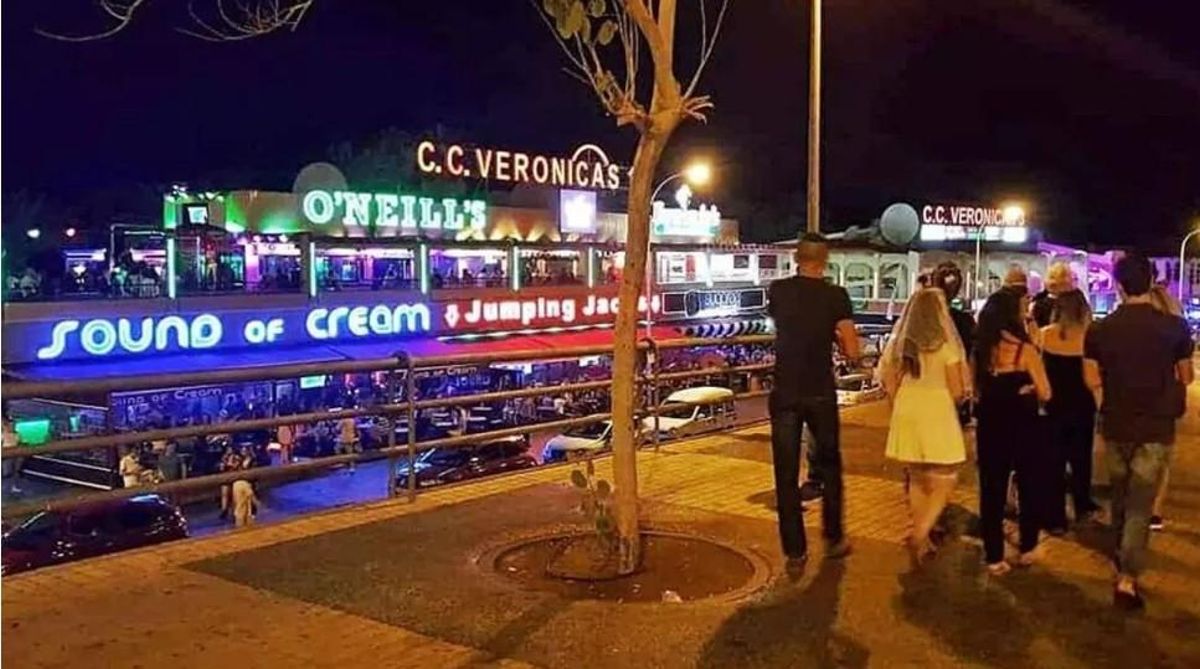This week, a short clip uploaded to TikTok and Instagram by the account @diariotenerife has opened a direct portal to 1999: the camera travels through Las Verónicas when the sign for Bobby’s Bar was still crackling in neon red, the promoters were handing out flyers in fluorescent t-shirts, and the white taxis were lined up next to the C.C. Starco.
The shaky footage, recorded in mini-DV, captures the soundtrack that defined the place, a mix of old-skool house and euro-dance.
Those 40 seconds are enough to remember that, on the cusp of the millennium, the strip in Tenerife was synonymous with low-cost debauchery and limitless fun, long before noise ordinances and lounge re-conversions. This video acts as a nostalgic flash that invites you to dive into the history, myths, and lights (and shadows) of the most famous nightlife strip in the south of Tenerife.
Epicentre of the Party
In the 90s, three small shopping centres aligned along Avenida Rafael Puig Lluvina, in Playa de las Américas, became the party epicentre of southern Tenerife.
Previously, at the beginning of the 70s, the developer who urbanised the area in front of Playa de Troya opened a small commercial block registered as Centro Comercial Verónica (the feminine form was catchy and easy to pronounce for the British visitors of the time).
As a second and third identical block opened—Verónicas II and III—customers began referring to the area in the plural: “Las Verónicas”, consolidating the name still found in guides and official directories.
That handful of establishments, illuminated by neon and surrounded by the scent of after-sun and cheap beer, established the “tacky & party” image that the British press attributed to the island following the 80s tourist boom. A decade later, programmes like Tenerife Uncovered, a British documentary-reality show broadcast by Sky One in 1999 that explored popular tourist destinations among young Britons with a sensationalist approach, would reinforce that reputation on a global scale.

Las Verónicas, in Playa de Las Américas (Arona). / El Día
Quick-Fun Urbanism
Las Verónicas was not a neighbourhood but a strip: three blocks with two floors and façades open to the pavement, with direct access to pubs on the ground floor and nightclubs on the upper floor.
During the day, the sound of fruit machines and some breakfast bars barely made a noise; but as the sun set, the air filled with flyers, compressed music, and the shouts of public relations staff offering shots and two-for-one drinks in broken English.
The flow included, almost in a straight line, the nearby Starco galleries and the emerging club Tramps, creating a continuous corridor of leisure that measured just over 300 metres but housed an unprecedented density of bars per square metre.
Nocturnal Fauna
Package deals and low-cost charter flights flooded the area with Brits, Irish, Scandinavians and, to a lesser extent, mainland Spaniards. With the peseta still in circulation, a fishbowl of vodka-Red Bull could cost 500 pts and a jug of beer barely 175 pts.
This currency differential, combined with lax opening hours (official closure at 6:00 am but unofficial extensions), made the place one of the cheapest bars in Western Europe.
The local clientele was notably absent: some bars openly advertised entry “for tourists only”, a practice that, although incredible, several public relations agents continued to use as a lure as recently as 2012.
Iconic Nightclubs
- Bobby’s Bar – Old-skool house, an open booth on the street. Its mixtapes circulated throughout the UK and are still preserved in recordings like those of Raw Jack (1994).
- Paradise Club – Jungle and imported drum & bass; DJs such as Kenny Ken and Ellis Dee passed through there.
- Jumping Jack’s – A classic name worldwide, evoking the legendary song by the Rolling Stones. UK Top 40 anthems and aggressive promotion of sambuca shots at 100 pts.
- Tramps – Three air-conditioned rooms. It proclaimed itself “King of Clubs” and anticipated the post-2000 renewal. It’s still going strong.
The Musical Pulse
The sound that prevailed from 1990-96 drew from the Valencian Ruta del Bakalao: machine, italodance and early Euro-house hits. By the mid-decade, British styles (hard-house, old-skool rave, drum & bass) landed with temporary DJs who worked a season on the island before jumping to Ibiza.
The makeshift booths, often little more than a formica counter, worked with vinyl imported alongside tourists’ luggage and promoters. This eclecticism explains why in the same hallway Take That coexisted with Let Me Be Your Fantasy by Baby D.
With the influx of visitors came late-night brawls, pickpocketing, and the omnipresent sale of counterfeit pills. Police checks were sporadic and, according to veterans of the scene, consisted more of deterrent presence than actual inspections. Nevertheless, excesses forced the Arona Town Hall to issue noise ordinances and tighten licenses.
Legacy
For many thirty-somethings today, Las Verónicas of the 90s symbolises a rite of passage: the first trip without parents, the freedom of opening hours, and the music that would later play in the pubs of their city.
Since then, the area has tried to reinvent itself with stylish lounges and noise controls, but its collective imagery remains anchored in that fluorescent decade of perpetual happy hours and beats at 140 beats per minute.
















